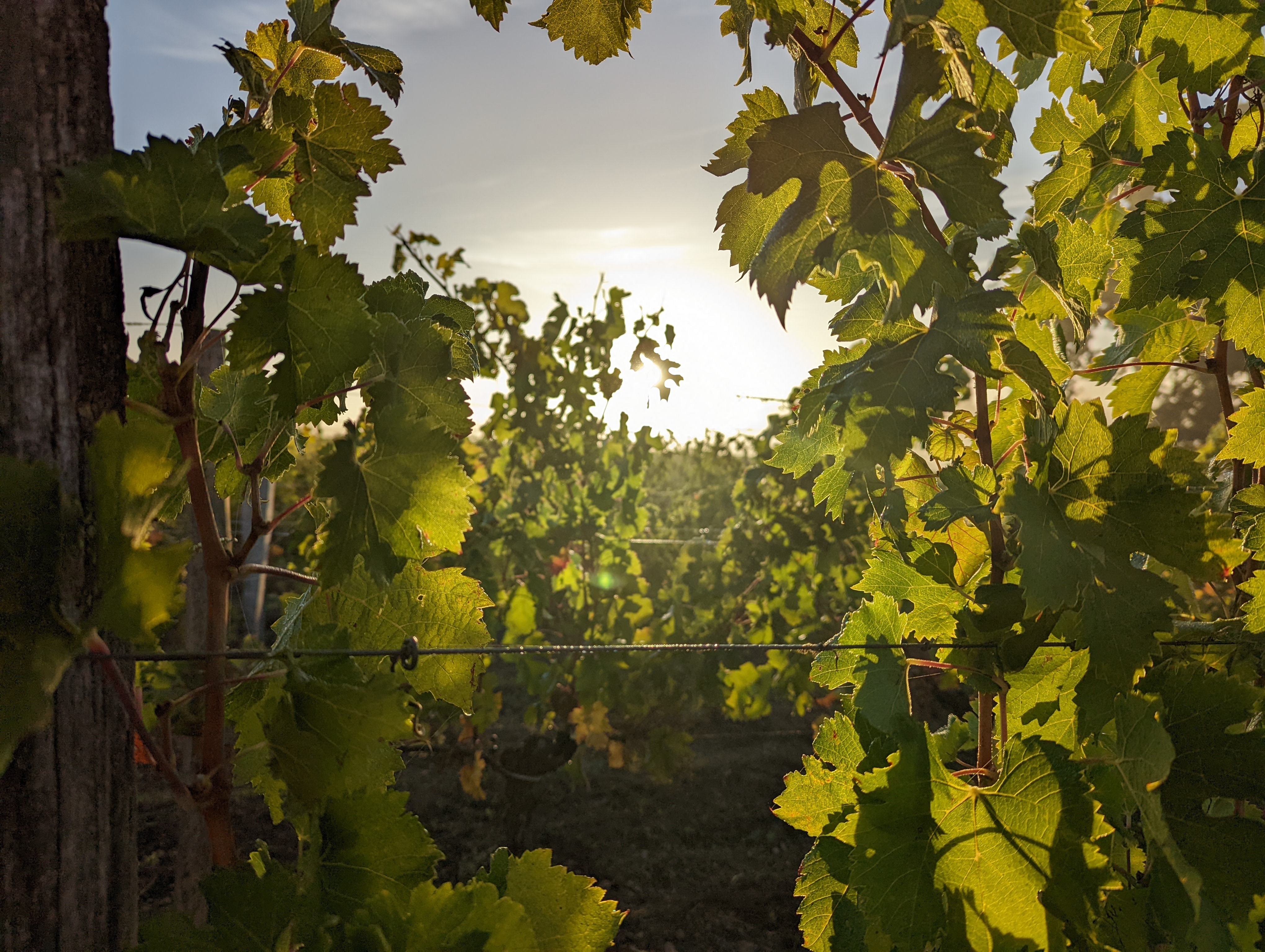An overview of South African viticulture
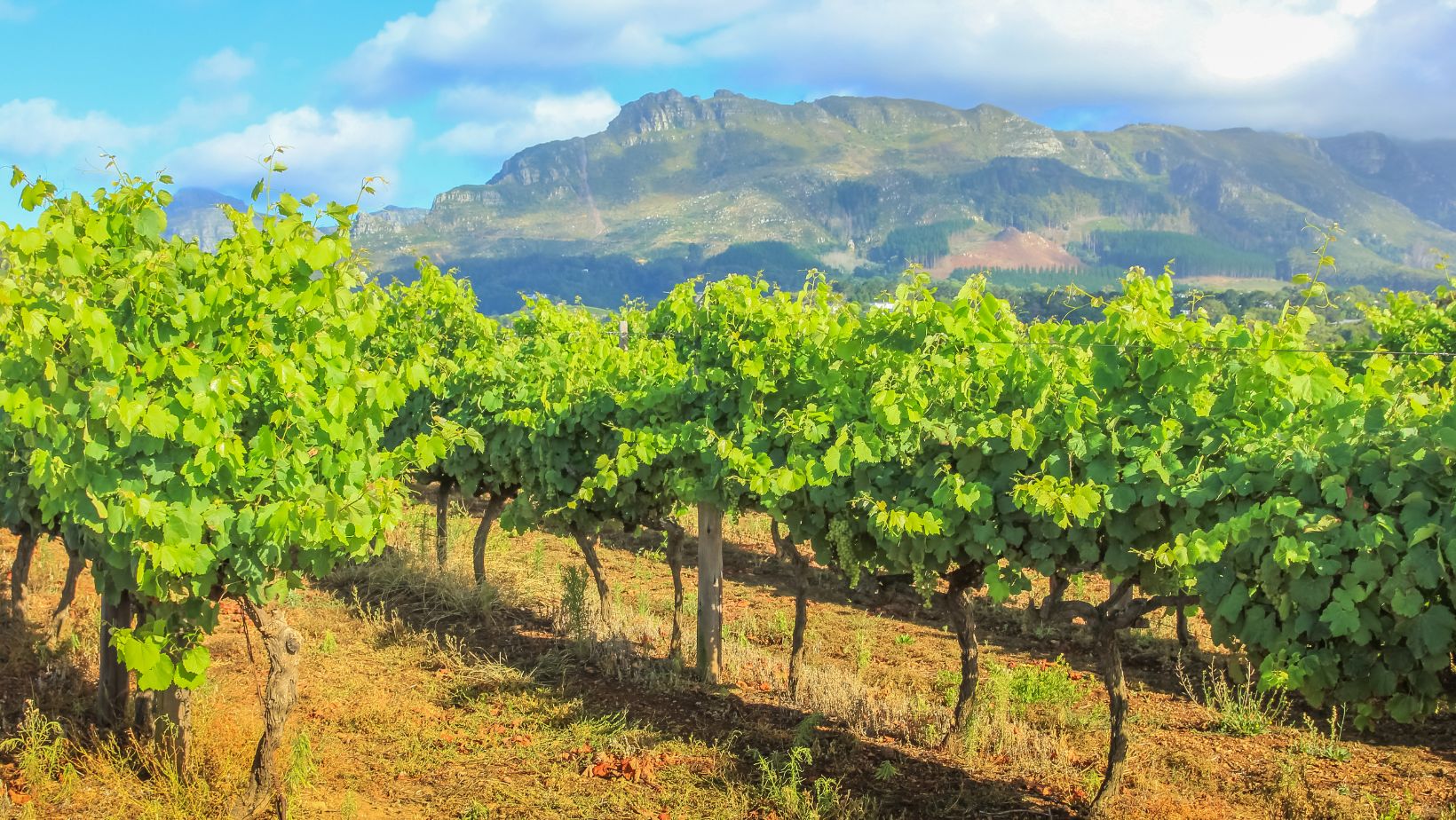
Wine, like cuisine, is an invitation to travel. We invite you to embark on a journey to the southern hemisphere and discover South Africa's wine passport, which for more than twenty years now has been one of the world's leading wine producers. A special mention goes to our Kroonpoort white wine, straight from the Kroonpoort vineyard in the Western Cape, acquired by Jean-Luc Sylvain in 2008, and whose 2023 vintage you'll soon be able to taste.
A little bit of History...
As the world's eighth-largest wine producer in 2022, with 10.2 million hectolitres (source: Statista.com), South Africa has carved out an enviable place for itself on the world wine scene. With only one indigenous grape variety, Pinotage, unlike Portugal, France or Italy, for example, this 'new world' country has always used mostly French grape varieties, and today produces some of the finest wines in the world.
Colonisation
South Africa's wine-growing history is closely linked to colonisation in the 17th century, when Dutch colonists set up a trading post at the Cape of Good Hope to serve as a supply base before leaving for the Indies. In 1659, they produced the very first South African wines from French Muscadel (or Muscat de Frontignan) grapes, giving rise to the oldest vineyard in the "New World". In 1688, the South African vineyard accelerated its development and became more professional thanks to the European winemaking techniques imported by the 200 French Huguenots (Protestants) who arrived from Languedoc and Charente.
In 1918, the creation of the KWV (Kooperatieve Wijnbouwers Vereiniging) by winegrowers from the Western Cape gradually enabled them to take responsibility for setting quotas, controlling prices and defining quality criteria such as reducing yields. This marked a turning point for the South African wine industry, which began to raise the quality of its wines.
Apartheid
Designed and introduced in 1948 in South Africa (Union of South Africa, then Republic of South Africa) by the National Party, the Apartheid policy rapidly isolated the country and its winegrowers. From 1976 onwards, international sanctions multiplied in protest against this racist system: diplomatic and trade restrictions were put in place, as well as import embargoes and a refusal to export. South Africa was excluded from all world organisations. As a result of numerous boycotts of South African products around the world, wine exports were halted. It was only with the abolition of Apartheid in June 1991 and the election of Nelson Mandela in 1994 that South African winegrowing experienced a renaissance, a veritable wine boom, and world markets opened up again. Winegrowers began importing new grape varieties, international boycotts were gradually abandoned and the planted area of South African vineyards expanded expansively. Pinotage quickly became a symbol of South Africa's openness to the world.
Today
Today, wine is a veritable industry in South Africa. In the space of 20 years, the country has become one of the 10 biggest wine producers in the world. With almost 90,000 hectares of vines* planted, by 2022 it will be ranked eighth in the world in terms of wine production volume, ahead of China and Germany. It is on a par with Chile and Australia. The country produced 3.9% of the world's wine in 2022.
Wine-growing regions
Most of South Africa's wine-growing regions are located close to the Atlantic or Indian Oceans, so many enjoy a rather Mediterranean climate, characterised by plenty of sunshine and dry heat. The presence of very high mountains in the background creates favourable conditions for the production of a wide range of wines.
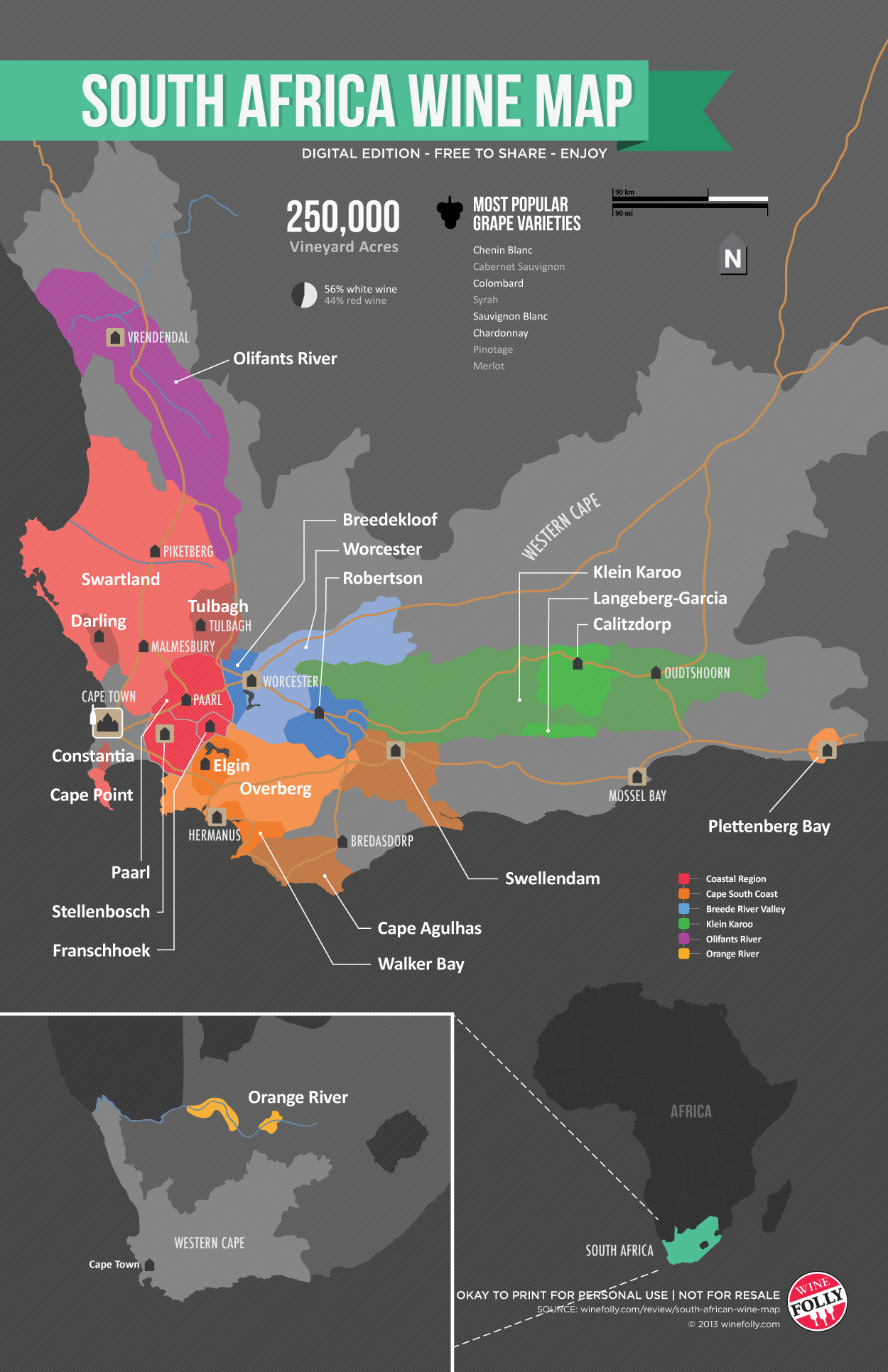 ©Winefolly.com
©Winefolly.com
Wine production is mainly concentrated in the Western Cape, with regions such as Stellenbosch, Paarl and Swartland renowned for their excellent red and white wines. The Walker Bay region, with its cooler climate, is renowned for its top-quality Pinot Noir and Chardonnay. The Breede Valley, Olifants and Orange River regions also make an important contribution, as they are often at the heart of bulk wine production and distillation. Thanks to these diverse regions, South Africa offers a wide range of wine styles, in keeping with its unique climate, soil and winemaking heritage.
Grape varieties
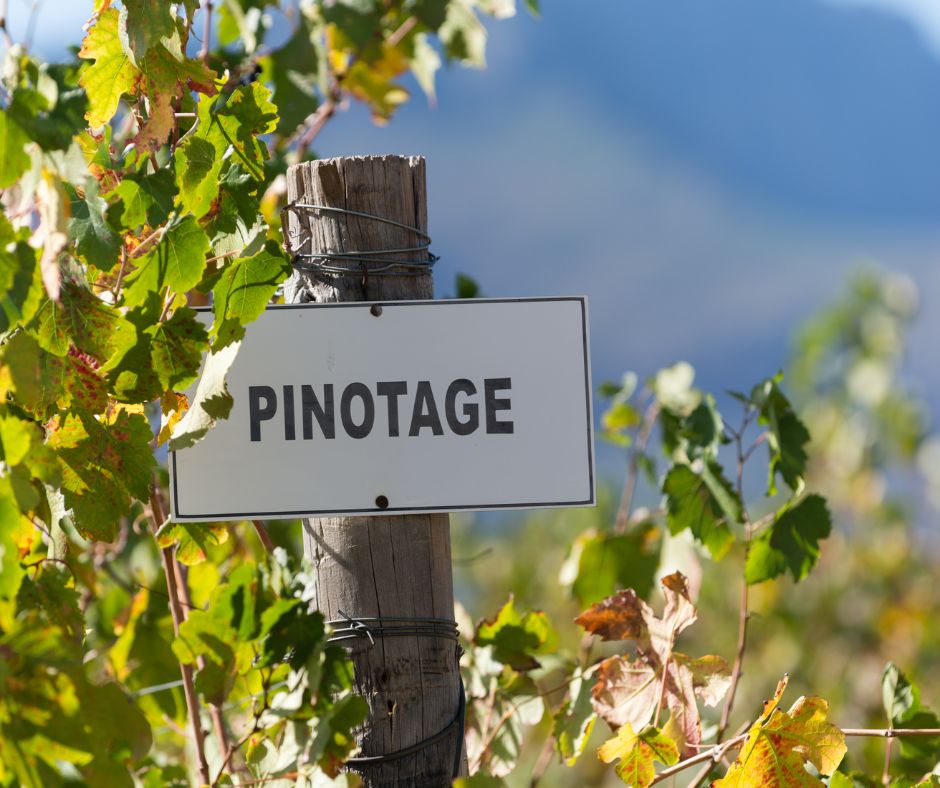
The South African wine industry continues to adapt and reorientate its offer in line with international trends in order to maintain its world ranking. Fifty-five percent of the vineyards are planted with varieties for white wines, led by Chenin Blanc (18.4%), and 45% with varieties for red wines, led by Cabernet Sauvignon (10.6% of the total), followed by Shiraz (or Syrah, 10%), Pinotage (7.4%) and Merlot (5.9%). The majority grape variety in South Africa is Chenin Blanc, just ahead of Cabernet Sauvignon.
Red wines
- Pinotage
This red grape variety is a cross between Pinot noir (originally from Burgundy) and Cinsault (originally from Provence), originally called Hermitage in South Africa, hence the name Pinot-age. It was created in 1925 by Abraham Izak Perold, researcher and first professor of viticulture at the University of Stellenbosh, as he sought to adapt Pinot Noir to the South African climate.
Pinotage is now a veritable signature of the South African wine industry, accounting for 6% of South Africa's total wine production. This grape variety produces powerful, tannic, dark-coloured wines with aromas ranging from black fruit to coconut, as well as spicy and peppery notes.
- Cabernet-Sauvignon
An increasingly important grape variety in Cape Town, Cabernet Sauvignon produces high-quality wines that develop well with age to become spicy, full-bodied and complex. As in Bordeaux, it can be blended with Merlot or its relative, Cabernet Franc. It is produced throughout the country, but the best results have been achieved in the Stellenbosch, Constantia, Overberg and Paarl regions. It has an impenetrable purple-red colour with violet highlights and fruity notes (wild berries and dried plums), cocoa and liquorice, cedar wood, followed by spicier and more herbaceous sensations.
- Syrah
Syrah or Shiraz is produced throughout South Africa. It accounts for 9% of the grape varieties grown, ahead of Pinotage. In South Africa, it benefits from optimum sunshine and a granitic schist terroir, giving it its finest expression of spiciness and refinement, with notes of characteristic black fruits, violets and lilac and a richness of chocolate. Aromas that make it particularly popular.
Other varieties are also grown for red wines, including Barbera, Cabernet Franc, Carignan, Cinsaut Noir, Gamay Noir, Grenache Noir, Malbec, Merlot, Mourvèdre, Petite Sirah, Ruby Cabernet, Touriga Nacional, Sangiovese, Tinta Barocca and Zinfandel.
White wines
- Chenin Blanc (also called Steen)
Emblematic of the great white wines of the Loire, Chenin Blanc is just as emblematic of the white wines of South Africa. It is mainly produced in the Stellenbosch and Paarl regions. This variety is the source of the best white wine in the world, voted in 2015: Kleine Zalze, Chenin Blanc 2013 made from 40-year-old, non-irrigated vines planted in the Stellenbosch region. This grape variety can produce both dry and sweet wines. It has aromas of citrus fruit and honey, as well as a certain acidity.
- Sauvignon Blanc
This great white grape variety is found all over the world and can produce exceptional or mediocre wines, depending on its ripeness and the work of the winemaker. In South Africa, the best wines come from the coolest regions and offer very pure flavours of citrus fruit, fresh herbs and seafood.
- Chardonnay
Chardonnay is a white grape variety that can adapt to both cool and warm climates. It is not aromatic, but its delicacy allows it to develop different aromas, reflecting the terroirs where it is grown and the way it is vinified. It has an intense straw yellow colour with green-gold highlights. It produces very fine wines, revealing aromas of white flowers (acacias), hazelnuts, almonds, brioche and citrus fruit when the wine is young. It also develops aromas of green fruit (apple, pear).
- Muscat d'Alexandrie
Also known as Hanepoot, Muscat d'Alexandrie is a white grape variety resulting from a cross between Muscat blanc à petits grains and Axina de tres bias (Trifera). It can be found in most of the country's vineyards, particularly in the Breedekloof district, around a hundred kilometres north-east of Cape Town. It covers two thousand one hundred and sixty-seven hectares, making up a significant proportion of the vineyards. It is the source of one of the world's greatest sweet wines: Vin de Constance.
It is one of the most widely planted and versatile varieties in the world. Locally, it was probably developed from "Spaanse Dryven" (Spanish grape) cuttings introduced to South Africa by Jan van Riebeeck in the 1650s. Nowhere else does a grape variety account for such a high percentage of a country's total harvest as in South Africa, where it is used in particular for dessert wines, made from grapes dried on the vine and affected by noble rot (like Sauternes). It is the source of one of the world's greatest sweet wines: Vin de Constance. Hanepoot has a powerful floral bouquet and an intense honeyed flavour.
Other grape varieties grown in South Africa for white wines are Bouquettraube, Chenel, Clairette Blanche, Colombar(d), Crouchen Blanc (Cape Riesling), Emerald Riesling, Gewürztraminer, Grenache Blanc, Muscat blanc, Marsanne, Pinot (Gris), Palomino, Semillon, Roussanne and Viognier.
Big ambitions and a "Vin d'origine" designation
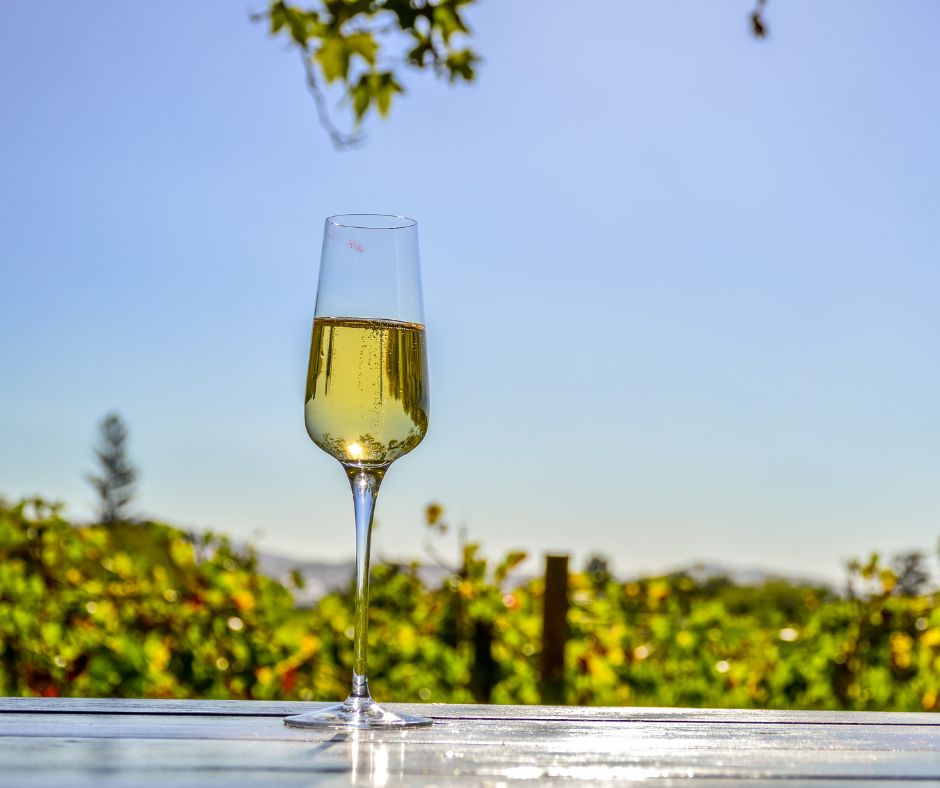 ©Canva
©Canva
As part of a qualitative approach and in order to promote the expertise of South African winemakers on the international stage, an ambitious programme was created in 2005: Winetech Vision 2020. The aim of this project was to define a common vision for the South African wine industry through consultation and research, and to renew its positioning, promotion and international sales strategy. In short, it was a question of inviting the South African wine industry into the big league. An audit of natural resources for terroir-based production, human resource development, ethical practices, positive discrimination, technology transfer, best practices and global quality standards and brand image was carried out. South Africa was embarking on the production of top-of-the-range wine.
South Africa's wine-growing regions were also defined under the "Wine of Origin" Act (Wyn van Oorsprong) of 1973. Following the example of the French appellation d'origine contrôlée (AOC) system, and in order to protect both producers and consumers, the South African wine industry has adopted the "Wine of Origin" classification system, abbreviated to "W.O.". All South African wines bearing the "Wine of Origin" label must be made entirely from grapes grown in the region. 75% of the grape varieties and vintages blended must be those shown on the label. To ensure that this is the case, the winemakers undergo regular quality control checks to guarantee the credibility of the appellation.
A total of 25 origin wine production areas have been identified: Bot River, Breedekloof, Cape Agulhas, Cape Town, Cederberg, Central Orange River, Darling, Elgin, Franschhoek, Klein Karoo, Kwazulu Natal, Lutzville Valley, Malgas, Olifants River, Overberg, Paarl, Plettenberg Bay, Robertson, Stellenbosch, Sutherland-Karoo, Swartland, Tulbagh, Walker Bay, Wellington and Worcester.
Kroonpoort
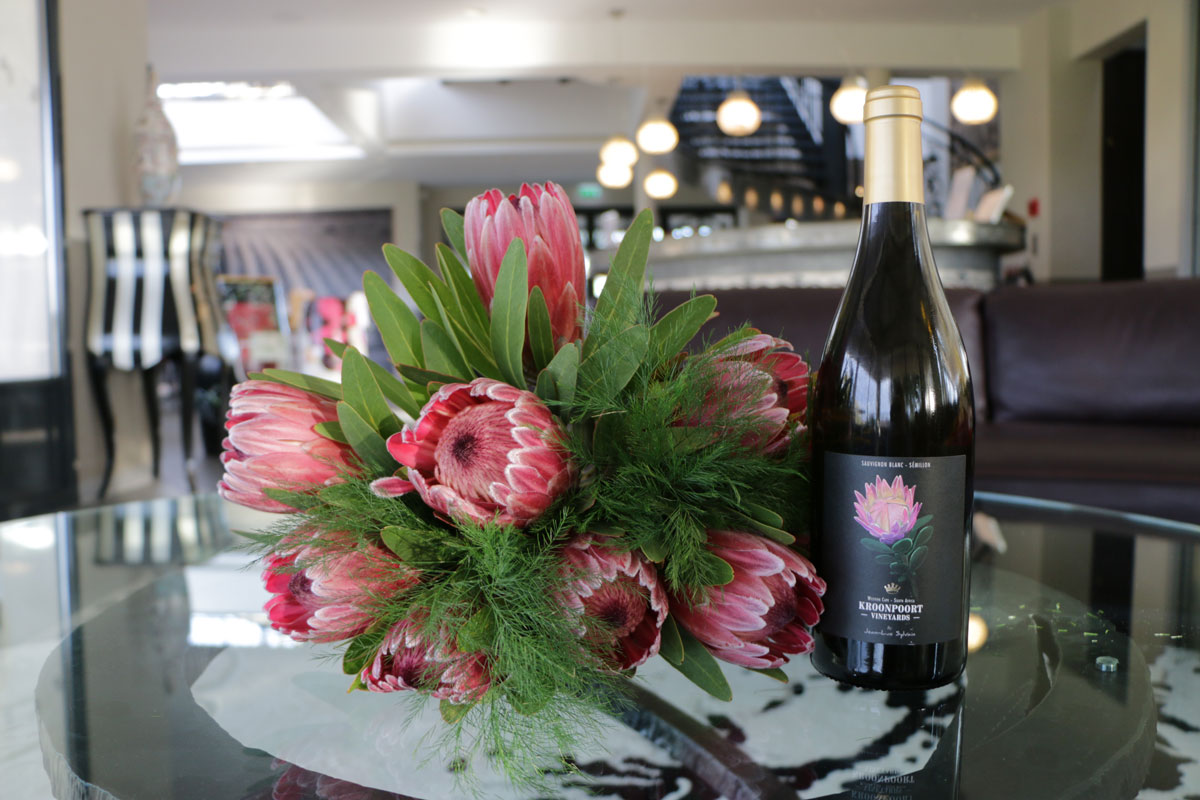
South Africa invites itself to Château La Rose Perrière with our white wine cuvée called "Kroonpoort". In 2008, Jean-Luc Sylvain acquired a 10-hectare vineyard, Kroonpoort Vineyard, located in the southernmost part of the Western Cape between the Indian and Atlantic Oceans. This new wine-growing region is particularly well-suited to the cultivation of Sauvignon Blanc thanks to a cooler climate than in the historical regions. Sauvignon Blanc accounts for 95% of this floral white wine, which is blended with 10% Semillon.
The name Kroonpoort in Afrikaans is made up of "Kroon", the crown, and "Poort", the gap between two mountains, a reminder of the vineyard's location in a valley surrounded by small mountains. Our South African cuvée can be recognised by the Protéa on the label, a brightly coloured flower that is emblematic of South Africa and characteristic of the Cape region. Most of these flowers are part of a biome known as 'fynbos' or scrubland. The unique characteristics of this region have earned it UNESCO World Heritage status.
Come and taste the elegance, power and aromatic complexity of South African Sauvignon Blanc with our 2023 vintage, available soon (March 2024) directly from the estate. Its aromas of exotic fruit and grapefruit make this a generous wine with a remarkably fresh palate that you can enjoy immediately or keep in your cellar.
*source: Wines of South Africa
